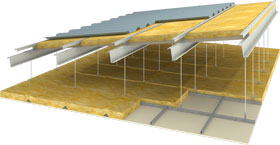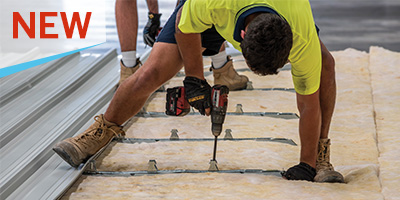Minimum energy efficiency standards for commercial buildings are now mandatory in the Building Code of Australia (BCA) and insulation plays a key role in achieving these requirements. Improvements in insulation also contribute to reductions in energy use which is a critical factor in Green Star accreditation.
Choosing the right building insulation also offers additional benefits to the occupants through the control of condensation, dampening noise and controlling heat flow in & out of the building. Critical to this selection process is the consideration of inorganic fibrous insulation which is deemed to be non-combustible and does not increase the fuel load in the building.
To achieve the required BCA Section J thermal insulation values, it is critical that the interface between the roof system and the building insulation be considered during the design phase. Key to this design consideration is allowing the correct amount of space under the roof sheet to ensure that the building insulation can recover to its design thickness and provide its rated insulation value. Failure to provide sufficient space will result in compression of the building insulation and degradation of its performance characteristics.
To ensure your projects meet the required levels of thermal performance, Bradford has introduced a Roof Spacer System in a range of sizes to suit all BCA building types and climate zones, including cyclonic regions. The Roof Spacer System raises the roof sheet above the purlin, creating a defined space between the safety mesh and the roof sheet for the building insulation.
To ensure the full recovery of the building insulation thickness, Bradford Roof Spacer System heights correspond to specifically developed Anticon insulation blankets designed to meet the BCA Section J requirements.

 Ashgrid system on pitched roof with ceiling. Create spec at DesignSmart.
Ashgrid system on pitched roof with ceiling. Create spec at DesignSmart.


